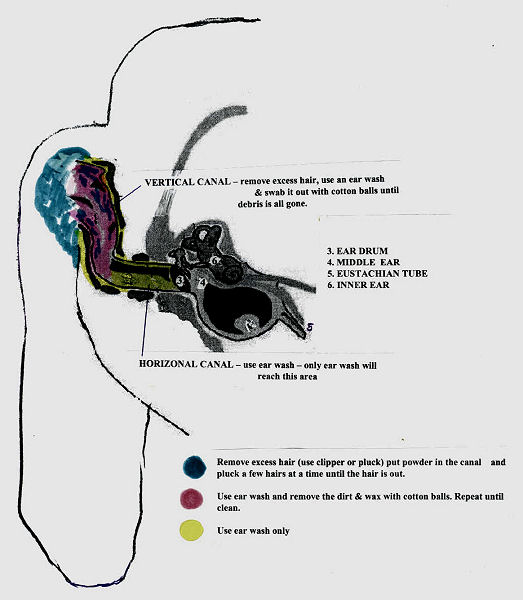|
Ears | |
|
There are two styles of dog-ears.
To understand the dog's ear problems better, we must initially understand that the dog's ear canal. From the beginning at the opening of the ear, the canal travels downward towards the dog's jaw. Then it makes a 45-degree turn and travels horizontally towards the eardrum. In other words, it bends while a human ear canal is straight. Also, most breeds have a much longer ear canal than humans. These differences can predispose the dog's ear to infection and make treatment of the entire canal much more difficult.
Most ear infections are easily treated if discovered early. There are two kind of infection areas: external ear canal (otitis externa) and middle ear (otitis media) Spinone are prone to ear infections because of the shape and design of their ears. Signs of Ear Infections:
. CAUSES: otitis externa infections:
otitis media infections:
PARASITES IN THE EAR Inflammation of the ear canal can be caused by a number of factors, such as parasites, microorganisms, foreign objects, skin problems or tumors. Ear mites are parasites that often can cause ear problems. However, less than 10 percent of all ear problems in dogs are the result of ear mites. Ticks and fleas are parasites commonly found in canine ear canals even less. For your dog to have ear mites, or other parasites, it must have had direct contact with another pet infested with them. So if your veterinarian diagnoses one animal in your house with ear mites, it is best to have all of your animals examined for possible infestations.
YEAST INFECTIONS Microorganisms like yeasts are the number one common cause of canine ear problems. Malassezia pachydermatitis usually is the culprit, and it loves to proliferate in warm, moist environments such as the dog's ear canal. A good sniff near the ear opening usually verifies a problem, as most yeast infectious ears are quite pungent. Certain bacteria such as Staphylococci, Streptococci, E coli, and Pseudomonas spp also can cause infections in the dog's ear, and in many cases both bacteria and yeast are present. If the infection persists, the ear canal will become inflamed and often discharge a purulent dark gummy substance. Not all ear infections are caused by the same microorganism; therefore, treatment without proper examination is difficult. Your veterinarian usually will take an ear swab and examine it under a microscope to determine the exact cause of the infection. This will enable a specific treatment plan to resolve the problem. Often, treatment will include flushing the ear canal with an antimicrobial solution and drying agent. An anti-inflammatory injection is then administered to reduce swelling and relieve the pain. The appropriate topical medication also will be dispensed for further treatment by the pet owner. Remember, all ear infections are not caused by the same microorganism; therefore, treatment without proper examination is strictly guessing.
ALLERGIES Allergies account for some of the most severe ear infections as does hypothyroidism. Persistent or recurring ear infections may be manifestations of other concurring diseases. Allergies often cause the dog to traumatize the ear themselves because of itching and this causes increased thickness of the skin and continual redness and swelling, which favors an environment for more extreme ear problems
PROPER EAR CARE
Proper ear care for your dog involves keeping the ear clean and dry. Check the ear weekly and clean as needed. Remove all hair that grows in the canal. It stops the airflow into the canal that keeps the canal dry. Use an ear powder to make hair removal easy for you and your dog. Be careful and pluck up a few hairs at a time until the whole canal is clean of hair. Flush the ear canal with liquid ear cleaner. (Commercial products can be found at most veterinarian clinics or pet shops). Put the cleaner in the ear; gently massage the base of the ears to distribute the solution around the normal ear folds, let the dog shake his head and then with a cotton ball, wipe out the excess cleaner and debris. Most ear cleaners have several functions. They not only clean the ear canal but also have an agent for liquefying was buildup, drying the ear canal, and changing the pH (acidity) in the canals. Most microorganisms prefer an environment that is alkaline; therefore, most ear preparations have an acid base. A cheap affected ear wash is white vinegar diluted 50:50 with water. THINGS NOT TO DO
YOUR DOG COULD HAVE AN EAR PROBLEM IF:
For Visual Instructions on Cleaning a Dogs Ears http://www.vetmed.wsu.edu/clientED/dog_ears.asp
Ear Cleaning Solution Recipes
Vinegar & Water Rinse1 part white vinegar 1 part water
Another Ear Cleaner8 parts liquid paraffin 1 part benzyl benzoate.
Yet Another Ear Cleaner 1 part white vinegar 1 part alcohol 1 part water
Blue Ear Cleaner Stuff16 oz Isopropyl Alcohol (or witch hazel) 4 Tablespoons Boric Acid Powder 16 drops Gentian Violet Solution 1% or (8 drops Gentian Violet Solution 2%)
GOOD PREPAIRED EAR CLEANERSEar Care Ear Cleaner & Ear Wax Remover (Bio Groom) all natural ingredientsFortified with Boric and Salicyclic Acid, dissolves ear wax buildup; mild and gentle; will not leave ear canal oily, sticky or gummyR-7 Natural Ear Cleaner; all-natural ingredients such as Chamomile and Marigold for their anti-inflammatory properties. St. John's Wort for its antibacterial and astringent properties, plus Rosemary for its anti-inflammatory properties and Lavender Oil for its pleasant odor and bacterial properties. Thornit Powder
Thanks to Sue Moen for this very thorough coverage on the Spinone ears |
||

